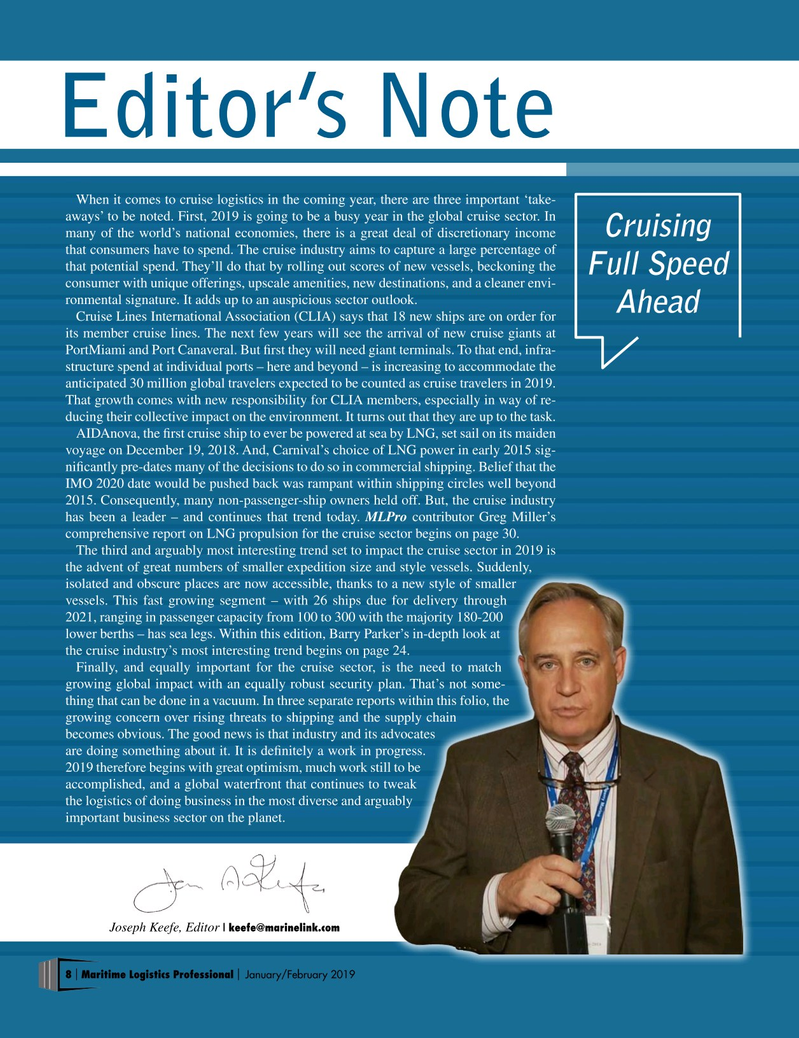
Page 8: of Maritime Logistics Professional Magazine (Jan/Feb 2019)
Cruise Ports Annual
Read this page in Pdf, Flash or Html5 edition of Jan/Feb 2019 Maritime Logistics Professional Magazine
Editor’s Note
When it comes to cruise logistics in the coming year, there are three important ‘take- aways’ to be noted. First, 2019 is going to be a busy year in the global cruise sector. In
Cruising many of the world’s national economies, there is a great deal of discretionary income that consumers have to spend. The cruise industry aims to capture a large percentage of that potential spend. They’ll do that by rolling out scores of new vessels, beckoning the
Full Speed consumer with unique offerings, upscale amenities, new destinations, and a cleaner envi- ronmental signature. It adds up to an auspicious sector outlook.
Ahead
Cruise Lines International Association (CLIA) says that 18 new ships are on order for its member cruise lines. The next few years will see the arrival of new cruise giants at
PortMiami and Port Canaveral. But frst they will need giant terminals. To that end, infra- structure spend at individual ports – here and beyond – is increasing to accommodate the anticipated 30 million global travelers expected to be counted as cruise travelers in 2019.
That growth comes with new responsibility for CLIA members, especially in way of re- ducing their collective impact on the environment. It turns out that they are up to the task.
AIDAnova, the frst cruise ship to ever be powered at sea by LNG, set sail on its maiden voyage on December 19, 2018. And, Carnival’s choice of LNG power in early 2015 sig- nifcantly pre-dates many of the decisions to do so in commercial shipping. Belief that the
IMO 2020 date would be pushed back was rampant within shipping circles well beyond 2015. Consequently, many non-passenger-ship owners held off. But, the cruise industry has been a leader – and continues that trend today. MLPro contributor Greg Miller’s comprehensive report on LNG propulsion for the cruise sector begins on page 30.
The third and arguably most interesting trend set to impact the cruise sector in 2019 is the advent of great numbers of smaller expedition size and style vessels. Suddenly, isolated and obscure places are now accessible, thanks to a new style of smaller vessels. This fast growing segment – with 26 ships due for delivery through 2021, ranging in passenger capacity from 100 to 300 with the majority 180-200 lower berths – has sea legs. Within this edition, Barry Parker’s in-depth look at the cruise industry’s most interesting trend begins on page 24.
Finally, and equally important for the cruise sector, is the need to match growing global impact with an equally robust security plan. That’s not some- thing that can be done in a vacuum. In three separate reports within this folio, the growing concern over rising threats to shipping and the supply chain becomes obvious. The good news is that industry and its advocates are doing something about it. It is defnitely a work in progress. 2019 therefore begins with great optimism, much work still to be accomplished, and a global waterfront that continues to tweak the logistics of doing business in the most diverse and arguably important business sector on the planet.
Joseph Keefe, Editor | [email protected] 8 Maritime Logistics Professional January/February 2019 | |

 7
7

 9
9
